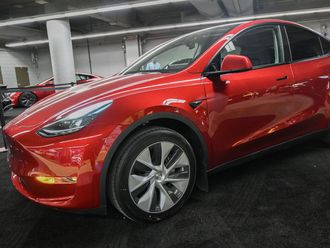
There are some 645,000 vehicles in the federal fleet. They encompass roughly 200,000 passenger vehicles, 78,517 heavy duty trucks, 47,369 vans, 847 ambulances and three limousines.
Each year, federal vehicles are driven about 4.5 billion miles, using almost 400 million gallons of gasoline and spewing more than 7 billion pounds of planet-warming greenhouse gases.
Now President JoeBiden wants to turn the entire fleet green.
In an executive order signed Wednesday, Biden directed federal officials to devise a plan for converting all federal, state, local and tribal fleets, including 225,000 Postal Service vehicles, to "clean and zero emission vehicles."
The declaration is a boon to the fledgling electric vehicle industry, which has grown exponentially in the past decade but still represents less than 2 percent of automobiles sold in the United States. And it represents yet another aspect of Biden's "all government" approach to fighting climate change; using the power of the purse, he aims to help boost American manufacturers of green products.
"It's important as a symbolic thing," said Timothy Lipman, co-director of the Transportation Sustainability Research Center at the University of California at Berkeley. "But I think it also will have a way of helping to jolt the industry forward at a time when it kind of needed that."
As of 2019, just 4,475 government-owned vehicles were electric, according to data from the General Services Administration.
According to Biden's order, officials will have 90 days to put together their plan for electrifying rest of the fleet. It's not yet clear what the timeline will be for eliminating combustion engine vehicles.
In the meantime, there are plenty of questions about how the government will achieve this transformation.
One of the biggest issues: Just three automakers currently manufacture electric vehicles in the United States, and none of those cars meet Biden's criteria of being produced by union workers from at least 50 percent American-made materials.
The closest is the Chevrolet Bolt, assembled at a General Motors plant in Lake Orion, Mich. But most of that car's parts - including the battery, motor and drive unit - are produced overseas.
But that could easily change, said Kristin Dziczek, vice president of industry, labor and economics at the nonprofit Center for Automotive Research. If Biden succeeds in making every car in the federal fleet electric, he would increase the total number of electric vehicles in the United States by more than 50 percent.
"One of the big questions for companies is, 'Is the consumer there?' Well, [the government] is a big consumer," Dziczek said. "Now they know there's some solid demand from the government to support their early launches of new vehicles."
Just a day after Biden's executive order, General Motors said it would end the sale of all gas- and diesel-powered passenger cars and light sports utility vehicles by 2035, with an aim of becoming carbon neutral by 2040.
At 640,000 vehicles, the federal fleet represents the annual output of about three or four automotive plants, Dziczek said. That's not exactly the million jobs Biden promised in his announcement Monday. But it might be sufficient to convince car manufacturers to change their supply chains or shift their production to U.S. facilities.
She was less optimistic that Biden's order would make manufacturers more supportive of unionization efforts at their plants.
A spokeswoman for Nissan, which produces the battery-powered Leaf in Smyrna, Tenn., said the company has no plans to seek a federal contract. Representatives for Chevrolet and Tesla did not respond to requests for comment.
In a statement, United Auto Workers president Rory Gamble said the union planned to work with the Biden on shifting away from combustion engines. In a recent white paper, UAW noted that electric drive trains require less labor to build, and the transition to electric vehicles could put some auto employees out of work. The union has called for manufacturers and policymakers to retool plants and retrain displaced workers for different jobs producing batteries, advanced breaking systems, electronics and other components.
Even before Biden's announcement, automakers had plans to produce 99 different models of electric vehicle in North America (currently there are 24). Global electrical vehicle sales grew in 2020 even while the rest of the car market suffered from the economic fallout of the coronavirus pandemic.
Once accessible only to the wealthy and ecologically minded, electric vehicles now boast sticker prices similar to their gas-powered counterparts. Since electric engines don't requires as much maintenance, these cars are actually less expensive to own in the long run.
Given the current demand for electric cars, the International Energy Administration projects that the global number of battery-powered and hybrid vehicles could increase from just over 5 million to nearly 140 million by 2030.
But if nations increase their investment in charging infrastructure and provide additional incentives, that number could be closer to 240 million - making about one third of all cars on the road electric.
"For an industry that is just starting to achieve liftoff," said Lipman, Biden's commitment to buying electric vehicles "puts more wind in its sails."








